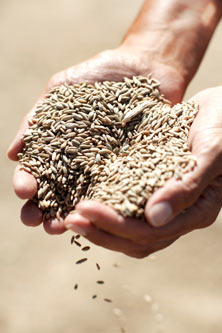

Grain Storage
It has been estimated that between one quarter and one third of the world grain crop is lost each year during storage. Much of this is due to insect attack. In addition, grain which is not lost is severely reduced in quality by insect damage. Grain pests preferentially eat out grain embryos, thereby reducing the protein content of feed grain and lowering the percentage of germinating seeds.
There is a zero tolerance policy on export and delivery of grain infested with live stored grain insects. Insect damage also impacts the viability of stored grain for the following season. Ideally, damaged grain should be replaced with damage-free seed.
Grain stored on farm should be ideally sprayed with insecticide and grain protectant, then transferred into a sealed silo with access to cool air (aeration).
Aeration is the practice of moving air through stored grain to cool the grain and thereby reduce the rate of grain deterioration and prevent storage losses.
Grain harvested at 15% moisture or higher provides an ideal environment for biological organisms such as insects, fungi, and bacteria to thrive. This can result in shot and sprung grain, poor germination and mould damage. Reproductive and developmental rates are greatly reduced in grain with moisture of lower than 13%. Hence, grain stored at lower temperature will remain viable for a longer period of time and is ideal for greater germination.
Aeration of silos should only be done on days with low temperatures and low humidity.
